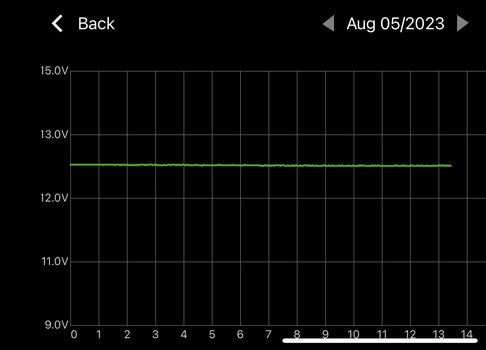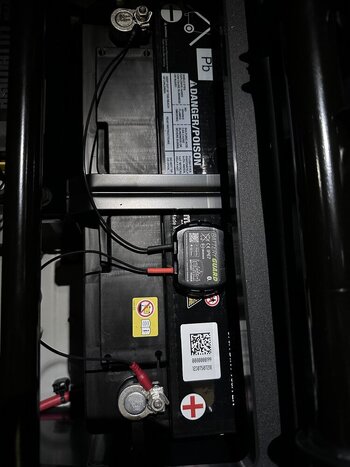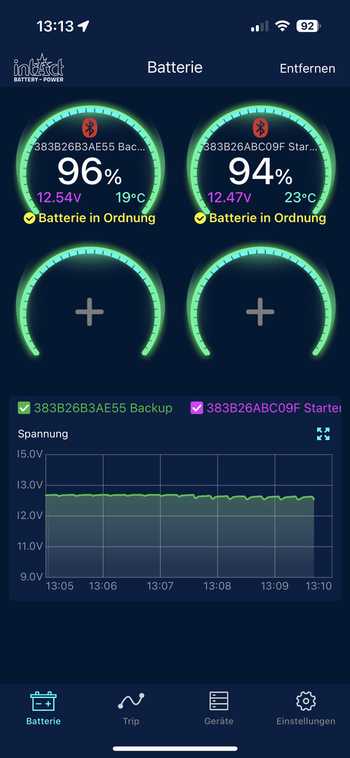The Grenadier Forum
Register a free account today to become a member! Once signed in, you'll be able to contribute to the community by adding your own topics, posts, and connect with other members through your own private inbox! INEOS Agents, Dealers or Commercial vendors please contact admin@theineosforum.com for a commercial account.
You are using an out of date browser. It may not display this or other websites correctly.
You should upgrade or use an alternative browser.
You should upgrade or use an alternative browser.
(The battery and monitor thread )Car dead in the middle of the woods
They aren't, they are using the body (possibly) or chassis as the earth. That may be the issue. Power from the positive pole on the battery.So how are they completing the circuit back to the battery if not using this terminal?
Upvote
0
Even if they are "grounded" to the body (which is common), the battery is the last terminal to which the current eventually flows. The body "collects" all the currents from various devices and eventually the current flows back to the battery via the battery cable, which is also connected to the body.
So everything must finally go through the terminal that @DCPU correctly pointed out.
So everything must finally go through the terminal that @DCPU correctly pointed out.
Upvote
0
Ok.They aren't, they are using the body (possibly) as the earth. That may be the issue.
An indication for consumers bypassing the Ineos software monitoring would be load status of battery monitors decreasing faster than the Ineos on screen one, right? Which is not the case so far, but I will keep observing.
Upvote
0
That is correct but the reading is from the shunt, if the earth wire is direct to the earth pole on the battery and not the common on the shunt it won't read correctly. It is effectively bypassing the shunt.Even if they are "grounded" to the body (which is common), the battery is the last terminal to which the current eventually flows. The body "collects" all the currents from various devices and eventually the current flows back to the battery via the battery cable, which is also connected to the body.
So everything must finally go through the terminal that @DCPU correctly pointed out.
Upvote
0
I don't know, but this is the only explanation. I've wired up a lot of these and the only way you get disparity is if the negative is being bypassed somewhere. Or there is a wiring issue. Shunts just read current flow in and out, you do get inaccurate readings from poor quality shunts but this seems to be way off.So how are they completing the circuit back to the battery if not using this terminal?
Upvote
0
Installed battery monitor to both batteries to collect some insight.
Initial numbers are:
- Ineos load status 78%
- Main battery monitor 70%
- Secondary battery monitor 30%
Lets see if it starts to make sense at some point.
That doesn't tell you anything if you don't know what the value is based on. If it's based only on voltage, it can't be correct at all, because that would require the monitor to know the battery's characteristics, age, charge/discharge cycles, type of chemistry, and a few other things (such as battery temperature).
True monitoring also requires knowledge of the Ri - internal resistance - of the battery, current monitoring and the ability to total amp-hours, as well as knowledge of the battery's rated capacity.
If voltage were suitable as the only monitoring parameter, a $1.00 voltmeter from Aliexpress ...
...would suffice. It would then be up to the user to interpret the voltage. And that is exactly what I described above: Without knowledge of the DUT (for @Jean Mercier: Device Under test), it's all guesswork, since no one knows what assumptions the monitor manufacturers have made.
Last edited:
Upvote
0
Yes the battery monitor may need to be calibrated, usually done by fully charging the batteries to float first. This should trigger the auto calibration to 100%, if it has this feature.There seems a huge disparity in what the actual voltage readings mean?
The battery monitor reads 12.04v and interprets this as 91%, green, battery OK; but your lookup table (not dissimilar to others) would put that voltage at under 25%.
Am I seeing this right?
Upvote
0
Although I can only guess, I would say that the sensor marked here is not a shunt, but a Hall sensor for current.
View attachment 7822409
From my understanding Hall Effect sensors are less accurate than shunts, could this be why there is disparity?Although I can only guess, I would say that the sensor marked here is not a shunt, but a Hall sensor for current.
View attachment 7822409
Upvote
0
I would NEVER EVER install a lithium battery other than a LiFePo in a car. Even if it is labelled "NASA", "Porsche", "Gucci" or "Rolls Royce". Not even from Bosch. Never.Would something like this work as a replacement for the service battery? A lithium Ion starting/deep cycle battery.

DL+ 12V 135Ah Dual Purpose 1000CCA LiFePO4 Battery
DL+ 12v 135Ah LiFePO4 Golf Cart & 1000CCA Automotive Battery. Free charger with 11 year warranty. 135 Amp Hours of deep cycle Dakota Lithium performance.dakotalithium.com
Upvote
0
Thermal runaway x 200+ EV vehicles = a large insurance increase in premiums for shipping and motor vehicle manufacturersI would NEVER EVER install a lithium battery other than a LiFePo in a car. Even if it is labelled "NASA", "Porsche", "Gucci" or "Rolls Royce". Not even from Bosch. Never.
View attachment 7822415
Upvote
0
I totally understand that my 70€ monitoring setup will not return absolute laboratory grade numbers, but hopefully allow me to understand when batteries drain and charge while camping, parking and driving. Simply to understand overall behaviour versus Ineos plans.That doesn't tell you anything if you don't know what the value is based on. If it's based only on voltage, it can't be correct at all, because that would require the monitor to know the battery's characteristics, age, charge/discharge cycles, type of chemistry, and a few other things (such as battery temperature).
True monitoring also requires knowledge of the Ri - internal resistance - of the battery, current monitoring and the ability to total amp-hours, as well as knowledge of the battery's rated capacity.
If voltage were suitable as the only monitoring parameter, a $1.00 voltmeter from Aliexpress ...
View attachment 7822407
...would suffice. It would then be up to the user to interpret the voltage. And that is exactly what I described above: Without knowledge of the DUT (for @Jean Mercier: Device Under test), it's all guesswork, since no one knows what assumptions the monitor manufacturers have made.
If that is understood, I feel I can plan and adapt to my needs.
Upvote
0
Both have their pros and cons.From my understanding Hall Effect sensors are less accurate than shunts, could this be why there is disparity?
A Hall sensor responds to magnetic fields in general, and there are a lot of them in a car. The quality of such sensors varies widely, but in professional applications they are accurate enough for the purpose. Professional automotive sensors are a different universe than $2 sensors from aliexpress. They cost much more and usually compensate for external noise.
A shunt is, after all, a resistor. Like any resistor, it burns energy and develops heat. The result is a lower voltage "behind" the shunt.
If you choose a higher resistance for the shunt, the effects get worse - but the accuracy increases. If you choose a lower resistance, the effects are mitigated, but the result is less accurate.
For monitoring a 100 Ah battery, a Hall sensor is accurate enough, I think. An noise error of 10,20,30 mA will probably even out over time. As opposed to shunts, Hall sensors do not require cutting a cable to install them. This is always a critical factor in high current applications. So imho the advantages of Hall sensors outweigh their disadvantages.
wording
Last edited:
Upvote
0
That's completely ok, and it wasn't criticism. I think I know you well enough to assume, that you know what you're doing. ;-)I totally understand that my 70€ monitoring setup will not return absolute laboratory grade numbers, but hopefully allow me to understand when batteries drain and charge while camping, parking and driving. Simply to understand overall behaviour versus Ineos plans.
If that is understood, I feel I can plan and adapt to my needs.
But I would very likely just install two cheapo voltmeters because they don't 'interpret' the voltage to their liking. A voltage would tell me more than a percentage. But that's just me. And I must admit that I'm spoiled by my RC-aircraft history. ;-)
If you want Bluetooth, perhaps something like this. But I've no idea if this is any good:
You'd need two of them.
But may be your monitor can display the voltages as well?
Last edited:
Upvote
0
It is pretty much the ones I installed.That's completely ok, and it wasn't criticism. I think I know you well enough to assume, that you know what you're doing. ;-)
But I would very likely just install two cheapo voltmeters because they don't 'interpret' the voltage to their liking. A voltage would tell me more than a percentage. But that's just me. And I must admit that I'm spoiled by my RC-aircraft history. ;-)
If you want Bluetooth, perhaps something like this. But I've no idea if this is any good:
You'd need two of them.
But may be your monitor can display the voltages as well?
They measure voltage as shown in the screenshots above. The % is just a gimmick.

I also get a visual of the log of up to 15 days.
Upvote
0
- Local time
- 7:30 AM
- Joined
- Jul 27, 2022
- Messages
- 6,005
Are we looking at the same thing?I don't know, but this is the only explanation. I've wired up a lot of these and the only way you get disparity is if the negative is being bypassed somewhere. Or there is a wiring issue. Shunts just read current flow in and out, you do get inaccurate readings from poor quality shunts but this seems to be way off.
There's only one actual voltage quoted. Is the comparison between two completely different %?
Upvote
0
Looks very fine, I like it.Done my battery monitor today, looks like that smartpass is doing what he should do.
First is Aux. battery, second starter
Cockpit shows 94%
Upvote
0
Similar threads
- Replies
- 51
- Views
- 3K
- Replies
- 26
- Views
- 2K
- Replies
- 36
- Views
- 2K
- Replies
- 19
- Views
- 1K





